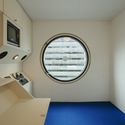
After ongoing uncertainties about the future state of the The Nakagin Capsule Tower Building, Kisho Kurokawa Architects and Urban Design Office Chiyoda-ku, have decided to dismantle the iconic architecture and regenerate its capsules as accommodation units and museum installations across the world. The regeneration plan follows the initial concept of "Metabolism", re-configurating the elements instead of complete demolition.
All of the capsules will be refurbished to their initial form through crowdfunding. Some of the capsules will be removed and donated to museums, while the rest will be "reused" as accommodation facilities. After many requests of transferring the capsules overseas to museums such as the Pompidou Center in Paris, the architects decided to display the capsules in museums across the world so many people can experience its unique design. A model room capsule is currently on display at the Museum of Modern Art Saitama, designed by Kisho Kurokawa.


Since 2018, the buildings has been operating as a "Monthly Capsules" facility, allowing people to stay at the tower as trial accommodation for one month. In almost two and a half years, the capsules have been used by over 200 people with positive feedbacks, which persuaded the team of architects to develop nationwide "accommodation capsules".
Crowdfunding has already begun on the Motion Gallery site since July 2nd to fund the repairs of the capsules being donated to museums.


Built in 1972, the Nakagin Tower was the first capsule architecture project, designed around the vision of an adaptable and dynamic architecture, where modules can be plugged into the central core, replaced, or exchanged. The capsules were designed to house traveling business people that worked in central Tokyo; therefore, each unit measuring 4x2.5 meters contains the necessary amenities to accommodate one person. All features and fixtures were factory-manufactured and pre-assembled.
News via PRTImes Japan
















